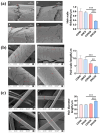Effects of Lactoferrin and Lactobacillus Supplementation on Immune Function, Oxidative Stress, and Gut Microbiota in Kittens
- PMID: 38998061
- PMCID: PMC11240779
- DOI: 10.3390/ani14131949
Effects of Lactoferrin and Lactobacillus Supplementation on Immune Function, Oxidative Stress, and Gut Microbiota in Kittens
Abstract
Immune deficiency is a prevalent issue among kittens, severely threatening their health and development by increasing susceptibility to infections and diseases. This study investigates the effects of dietary supplements containing lactoferrin and Lactobacillus plantarum (L. plantarum) on the immune function, intestinal health, and microbiota composition of kittens. The results demonstrate that these supplements significantly enhance immune responses, with immunoglobulin A (IgA) levels increasing by 14.9% and IgG levels by 14.2%. Additionally, there was a notable 28.7% increase in catalase activity, indicating a reduction in oxidative stress. Gastrointestinal (GI) health improved markedly, evidenced by increased populations of beneficial bacteria such as Lactobacillus, which rose from 4.13% to 79.03% over the study period. The DNC group also showed significant reductions in pro-inflammatory cytokines, including decreases of 13.94% in IL-2, 26.46% in TNF-α, and 19.45% in IFN-γ levels. Furthermore, improvements in physical conditions were observed, including enhanced coat condition and mental status. These findings underline the potential of lactoferrin and L. plantarum as effective dietary interventions to improve kitten health, thereby reducing dependency on antibiotics and mitigating associated risks. This research provides a scientific foundation for optimizing nutritional management practices to enhance the overall vitality of kittens during their critical growth phases.
Keywords: Lactobacillus; gut microbiota; immune deficiency; kittens; lactoferrin.
Conflict of interest statement
Weiwei Wang, Longjiao Wang, and Wei Xiong, co-authors of the article, are affiliated with Henan Zhiyuan Henuo Technology Co., Ltd. and are employed as technical consultants at the company. The authors declare no conflict of interest.
Figures








Similar articles
-
Bifidobacterium lactis and Lactobacillus plantarum Enhance Immune Function and Antioxidant Capacity in Cats through Modulation of the Gut Microbiota.Antioxidants (Basel). 2024 Jun 25;13(7):764. doi: 10.3390/antiox13070764. Antioxidants (Basel). 2024. PMID: 39061833 Free PMC article.
-
Dynamic development of gut microbiota and metabolism during and after weaning of kittens.Anim Microbiome. 2025 Jan 18;7(1):10. doi: 10.1186/s42523-024-00373-w. Anim Microbiome. 2025. PMID: 39827164 Free PMC article.
-
Lactobacillus reuteri derived from horse alleviates Escherichia coli-induced diarrhea by modulating gut microbiota.Microb Pathog. 2024 Mar;188:106541. doi: 10.1016/j.micpath.2024.106541. Epub 2024 Jan 13. Microb Pathog. 2024. PMID: 38224920
-
Supplementation of Diets With Bovine Colostrum Influences Immune and Gut Function in Kittens.Front Vet Sci. 2021 Aug 10;8:675712. doi: 10.3389/fvets.2021.675712. eCollection 2021. Front Vet Sci. 2021. PMID: 34447799 Free PMC article.
-
The Orphan Kitten.Vet Clin North Am Small Anim Pract. 2025 Jun 9:S0195-5616(25)00054-3. doi: 10.1016/j.cvsm.2025.04.004. Online ahead of print. Vet Clin North Am Small Anim Pract. 2025. PMID: 40494672 Review.
Cited by
-
Alterations in the Intestinal Microbiome and Metabolic Profile of British Shorthair Kittens Fed with Milk Replacer.Animals (Basel). 2024 Aug 14;14(16):2346. doi: 10.3390/ani14162346. Animals (Basel). 2024. PMID: 39199879 Free PMC article.
-
Immunomodulatory effects of Lactiplantibacillus plantarum CCFM8661 + stachyose on cyclophosphamide-induced immunosuppression mice.Front Immunol. 2025 Jan 27;16:1513531. doi: 10.3389/fimmu.2025.1513531. eCollection 2025. Front Immunol. 2025. PMID: 39931067 Free PMC article.
References
-
- Estepa-Becerra J.A., Cajiao-Pachón M.N., Monsalve-Barrero S. Canine and feline population management within the One Welfare framework: A retrospective look Bogotá 2004 to 2021. Rev. MVZ Cordoba. 2023;28:27. doi: 10.21897/rmvz.2925. - DOI
-
- Peña-Corona S.I., Gomez-Vazquez J.P., López-Flores E.A., Vargas Estrada D., Arvizu-Tovar L.O., Pérez-Rivero J.J., Juárez Rodríguez I., Sierra Resendiz A., Soberanis-Ramos O. Use of an extrapolation method to estimate the population of cats and dogs living at homes in Mexico in 2022. Vet. Mex. 2022;9 doi: 10.22201/fmvz.24486760e.2022.1001. - DOI
-
- Biezus G., Machado G., Ferian P.E., da Costa U.M., da Silva Pereira L.H.H., Withoeft J.A., Nunes I.A.C., Muller T.R., de Cristo T.G., Casagrande R.A. Prevalence of and factors associated with feline leukemia virus (FeLV) and feline immunodeficiency virus (FIV) in cats of the state of Santa Catarina, Brazil. Comp. Immunol. Microb. 2019;63:17–21. doi: 10.1016/j.cimid.2018.12.004. - DOI - PubMed
Grants and funding
LinkOut - more resources
Full Text Sources
Miscellaneous

